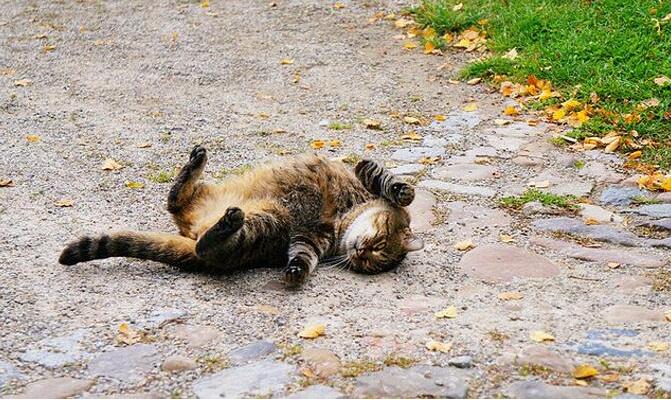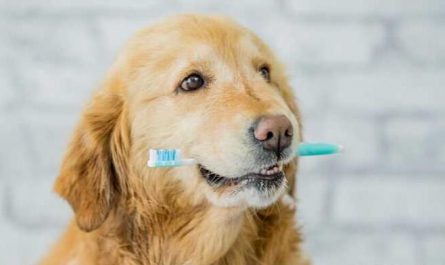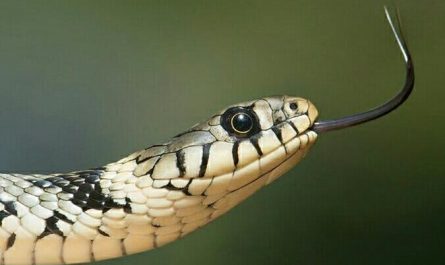The reason why the cat is rolling on the ground
Cats just like to roll and rub around. I think this is a way for him to express his feelings. My cat rolls when he is excited. There is a gland in the back and neck of the cat that can secrete odor. Humans can’t smell it. , So sometimes its head is on the ground and on the wall to leave a smell! And it’s acting like a baby
1. When will the cat roll on the spot, stretch its limbs, open its mouth, dance its claws, and gently swing its tail tip-for strangers, cats seldom take the risk of doing this posture, because it is extremely easy for a cat to do it Was hurt, so when the cat made this gesture, it said: “I trust you!”
2. Cats are very capable of recognizing smells. When they meet you, they will wipe you sideways first, and then sit down and taste your taste-the way is to lick the hair that it has carefully wiped on you with your tongue. .
3. Dogs wagging their tails are not necessarily happy. Cats wagging their tails must be angry. The emotions that cats wag their tails most of the time are expressing—contradictions and dilemmas. If the cat barks and wants to go out, but finds heavy rain after opening the door, then it will start to wag its tail. If it ignores the rain and rushes out to stand for a while and gets soaked all over, its tail will wag even more fiercely. Once it made up its mind-ran back into the house or set off bravely for a cruise, its tail immediately stopped wagging.
Cats are not as straightforward as dogs in expressing good feelings, so that we often think cats are unfriendly and indifferent.
In fact, cats will show good feelings, to people, to other cats, and even to those who deliver babies or take care of kittens. How do cats show their affection for you? There are several ways:
1. The most common way to express good feelings is to wrap your tail around you, touch your legs with your head or body, and rub the back of your ears or face against you. This is to leave a familiar smell on you, make it more comfortable, or it may treat you as its subordinate.
2. Licking you, like licking other cats, which means trust and goodwill.
3. After a person touches it, it will lick itself and “taste” the smell of the person. This smell is something we can’t smell but cats can detect.
4. When the cat is lying on your lap, it must have a good impression of you, and it will not jump on the lap of someone you don’t like.
5. It brings you a “gift”, such as a dead mouse, which means that it has a good impression of you and also that it thinks you are its mother.
6. The cat’s straight tail is a very strong opinion. You will find that when a cat approaches a person or cat it does not know, its tail hangs down.
7. Rolling the body means “play with me”, and the cat will not play with people it doesn’t like.
8. Putting the paw on your arm is “reiterating” that it feels good for you.
9. When it slowly bends its back and rubs your legs, it says to you: “I love you!”
10. There are many reasons for a cat to grumble and bark. If it barks like this when rubbing you, it means that it really loves you
Ten common cat diseases and prevention methods
1. Ectoparasites
① Fleas: Red stains on the skin are formed by wet feces.
Treatment method: You can use anti-flea agent or anti-flea collar to apply anti-hair on the cat’s feet, back, tail, and buttocks, to avoid getting wounds or eyes, such as skin redness, hair loss or allergies , Take a bath in time to remove the drug residues or take it to the pet for disposal.
Prevention: When going out, you can use more to remove fleas to avoid bringing them home.
②Ear mites: Ear mites are easier to identify. There are black greasy dirt in the ears of cats, and they often scratch the back of the ear roots with their paws.
Treatment method: ear oil drops.
2. Endoparasites
Fleas are the intermediate hosts of parasites and can be transmitted to humans. So be sure to deworm your body.
Treatment method: use in vivo deworming tablets for cats to deworm them regularly. In the few days after taking the medicine, the litter should be changed frequently to avoid secondary infection of the eggs.
3. Feline viral rhinotracheitis
Kitten symptoms: The incubation period is 2-6 days. Kittens are more susceptible than adult cats, with paroxysmal coughing, sneezing, tearing, conjunctivitis, loss of appetite, weight loss, depression, increased nasal secretions, and serous beginning , And then become purulent.
Adult cat symptoms: infection is caused by congestion of the cornea in the eye, difficulty in eating in the mouth, continuous discharge of secretions from the mouth, and smelly. Chronic sinusitis, ulcerative conjunctivitis and ophthalmia are the main features. The inflammation of the nasal cavity can narrow the respiratory tract, making it difficult to breathe and suffocating.
Treatment method: antibiotics, concurrent treatment for other complications.
4. Enteritis
Pay attention to whether it is common enteritis or viral and infectious enteritis. In the hospital diagnosis, mixed inflammation of gastroenteritis is more common.
Symptoms: enteritis (mainly diarrhea), duodenal inflammation (mainly vomiting), small intestinal mucosal bleeding (mainly manifested as black or black-red stool), large intestine and colonic mucosal bleeding (mainly manifested by fresh blood in the stool or Blood clot). Enteritis caused by bacterial infection (mainly manifested as increased body temperature, depression, decreased appetite or annihilation, animal dehydration, weight loss, acidosis, waist arch, abdominal pain, and sensitivity to pressure on the abdominal wall). Chronic enteritis (mainly manifested as mild systemic symptoms, but repeated diarrhea, and animals exhibit dehydration, weight loss, and malnutrition).
Treatment: ①Oral rehydration salts to prevent dehydration, give high-nutrition, easy-to-digest foods, take Modi cat probiotics to improve the balance of gastrointestinal flora, regulate and improve gastrointestinal function. ② Anti-inflammatory and antibacterial. ③ Symptomatic treatment, hemorrhagic enteritis should pay attention to hemostasis. ④ Deworming drugs should be given to enteritis caused by parasites.
5. Urinary tract infection
It is caused by bacteria, urethral obstruction, urethral stones, and “idiopathic” factors, which are manifested as frequent urination, difficulty urinating, or blood in the urine.
Treatment method: ①Severe surgery. ② Use anti-inflammatory drugs for bacterial infections. ③Catheterization. ④Supply taurine, but be careful not to cause metabolic urinary toxicity due to excessive acidification, and feed prescription food.
6. Ringworm in cats
Due to the long treatment period, it is difficult to cure, easy to be infected, easy to recur, and it can also be transmitted to humans, causing itching and peeling of human skin. Feline ringworm is more common in malnourished and frail cats.
Symptoms: Feline ringworm is a fungal infection of the skin. It usually appears on the face, limbs and tail, with round or oval ringworm spots covered with gray scales. Violet fluorescent spots can be seen by ultraviolet light. . The hair color is rough, the ringworm spots and coats fall off, and it is extremely itchy. Repeated scratching and alopecia areata.
Prevention: Supplement nutrition, enhance nutrition for cats, especially increase the intake of B vitamins, which will help improve cats’ resistance and speed up the treatment of tinea cats. In addition, cat owners can also take some vitamin tablets to prevent infection.
Treatment: Go to the pet hospital for regular treatment.
7. Stomatitis
The etiology is quite complicated, and many reasons can cause oral inflammation.
Symptoms: Specific symptoms, feeling of hunger, wanting to eat but not daring to eat, when the food enters the mouth, it stimulates the inflammation part and causes pain, and the affected cat suddenly howls and escapes. Mouth salivation, some stretch the tongue out of the mouth, longer time gradually lose weight.
Treatment: Go to the pet hospital for regular treatment.
8. Infectious peritonitis
A chronic, progressive infectious disease of cats caused by feline infectious peritonitis virus. The incidence is more common in cats between 1 and 2 years old and elderly cats. Purebred cats are mostly found in domestic cats.
Symptoms: loss of appetite or intermittent anorexia. Body temperature rises by 39.7°C—41°C. After 7-40 days, a significant increase in abdominal circumference can be seen. As the abdominal circumference increases, it may show dyspnea, anemia, and weight loss. The cat will fail and die after several weeks of disease.
Clinical diagnosis: A large amount of ascites accumulates, and there is generally no obvious pain when the abdominal wall is palpated.
Treatment: The pathogen is a coronavirus and can be killed by commonly used disinfectants.
9, cat plague
Feline distemper is also called feline panleukopenia or feline infectious enteritis. It is a highly contagious infectious viral disease. Cats with incomplete or unvaccinated vaccines are prone to cat plague. It mainly occurs in kittens less than one year old, especially kittens aged 3-5 months. Sick cats contain large amounts of virus in their vomit, feces, urine, saliva, nose and eye secretions. Even a few weeks to more than a year after a sick cat recovers, the virus can still be excreted from the feces and urine. These excreta and secretions contaminate feed, drinking water, utensils or the surrounding environment, which can spread the disease. It is a very dangerous infectious disease most common in domestic cats.
Symptoms: poor spirits, long sleep time, rough coat, indifferent to the host’s call and the environment. Refusal to eat or decreased appetite, and gradually stopped eating after the onset. The body temperature rises to above 40°C, continues for about 24 hours and then drops to normal temperature, but can rise again after 2-3 days, showing a typical dual-phase heat type. Vomiting is its most important feature. Diarrhea, bloody, watery stools, severe dehydration, and rapid weight loss. Dehydration and secondary bacterial infections are often the cause of sudden death.
Other complications: including oral ulcers, blood dysentery, jaundice, and extensive intravascular coagulation syndrome. The course of the disease exceeds 5-7 days without fatal complications, and it can often recover; the number of white blood cells will return to normal within 24-48 hours after the course of the disease.
The pet’s diagnosis: blood test of sick cat is characterized by a sharp decrease in white blood cells. (4-6 days after infection dropped to below 4000/ml).
Treatment method: 1. Isolate from other pets to avoid infection. 2. Infusion prevents dehydration, regulates body fluid balance and corrects acidosis. 3. Improve vomiting symptoms. 4. Give broad-spectrum antibiotics to prevent secondary bacterial infections. 5. Give plasma transfusion for severe anemia.
Prevention method: inject cat plague vaccine.
Precautions: During the treatment, because of the intake of a large amount of antibiotics, the cat’s normal digestive flora was destroyed during the treatment. It is necessary to give the cat some drugs to regulate digestion, such as Modi probiotics for cats, probiotics Take 2-3 hours apart from antibiotics. In the later stages of recovery, light food should be the main diet. For nutritional supplements, you can eat nutritional cream for cats, which is more comprehensive and digestible.
10. Diabetes
Cats over 8 years old are common and are a chronic disease.
Symptoms: polydipsia, polydipsia, polyuria, anorexia, poor spirits (with symptoms of acute pancreatitis). Ophthalmic diseases such as corneal ulcers and cataracts appeared later.
Diagnosis: Blood glucose and blood ketones are elevated in blood test. Urine test showed high urine sugar.
Treatment: ①Inject insulin according to body weight. Until diabetes ceases and the symptoms of ketoacidosis are relieved. ②Inject potassium chloride. ③Inject sodium bicarbonate. ④ Pay attention to the control of glucose content in food.






